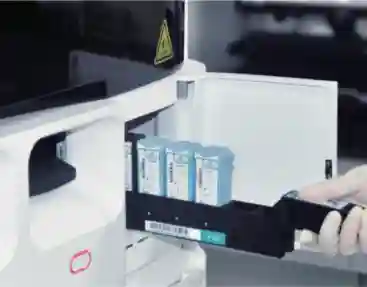IHC Stainers for Small Labs: 3 Compact Models with CLIA Compliance
Selecting the IHC staining equipment for smaller laboratories is crucial to optimize space utilization and cost-effectiveness while improving operational efficiency and ensuring compliance with CLIA regulations.
What Are the Key Features of IHC Stainers for Small Labs?
When small laboratories are deciding on IHC stainers to use in their facilities, it’s essential to look at features that match the lab’s requirements thoroughly. This helps guarantee that the stainers not suit the limited physical space available in smaller labs but also deliver consistent and effective performance.
Compact Design and Space Efficiency
Small labs often face space constraints, making compact design a key feature for IHC stainers. A strainer with a small footprint can easily fit into limited space, allowing you to maximize your laboratory area without sacrificing functionality.
Ease of Use and User-Friendly Interface
Having an interface that’s easy to use is crucial for smooth operations in small laboratories where employees often have to juggle multiple tasks simultaneously. The simplicity of the interface allows for training of staff and seamless integration of the stainer into your work process without significant downtime or steep learning curves.
Cost-Effectiveness and Budget Considerations
Small laboratories with funds often need to carefully consider costs when choosing an IHC stainer that strikes the right balance between affordability and performance quality to ensure maximum value within budget constraints.
CLIA Compliance and Quality Assurance
Compliance with the regulations of CLIA standards is very important in the upkeep of standards of quality, in laboratory procedures. A CLIA-compliant staining machine provides you with a guarantee of its reliability and accuracy which translates to consistent results.
Which Three Models Are Available?
Choosing the model from the lineup can have a notable influence on how well your lab operates and performs effectively. Below are three models that comply with CLIA standards and are tailored for smaller labs.
Model A: CNT360 Full-automatic IHC&ISH Stainer
Technical Specifications
The CNT360 model is an automated machine for immunohistochemistry staining that processes 60 samples at a time and finishes staining within 2 and a half hours. This feature adequately fulfills the requirements of the department. Facilitates the incorporation of new technology advancements like chromogenic, in situ hybridization.
Unique Features
This tool allows for color immunohistochemistry and tasks such, as p16/Ki67 staining to cater to different needs in your laboratory setting.
Pros and Cons
Its strengths lie in its ability to process a volume of tasks efficiently and its compatibility, with intricate staining methods. Nevertheless, it may demand training upfront when contrasted with more straightforward models.
Model B: CNT330 Full Automatic Multiplex IHC Stainer
Technical Specifications
The CNT330 model provides options for multiplex immunofluorescence (MIF) aiming to minimize discrepancies in its approach compared to existing systems such, as Akoya Opal.
Unique Features
This model improves multiplexed imaging results by increasing signal intensities and improving signal-to-noise ratios while ensuring clear biomarker localization.
Pros and Cons
The advantages of this product are its signal intensity and seamless integration with current processes while a potential drawback could be its dependence, on particular reagents that might restrict adaptability.
Model C: CNT300 Full Automatic Multiplex IHC Stainer
Technical Specifications
The CNT300 model delivers staining outcomes using proprietary secondary antibody detection systems and, over 200 quality assurance products.
Unique Features
Its automated staining platform seamlessly integrates with workflows whether using automated systems or manual methods.
Pros and Cons
One advantage is the top-notch outcomes thanks, to the detection mechanisms employed but occasional upkeep inspections might be needed to maintain peak efficiency.
How Do These IHC Stainers Enhance Laboratory Efficiency?
Efficiency is crucial, in the laboratory to keep productivity high and ensure outcomes are achieved, with these models providing various features that improve efficiency in the lab;
Automation Capabilities
Automating tasks cuts down on work and lets you concentrate on analyzing instead of doing repetitive chores. This boosts productivity while reducing the chances of mistakes.
Precision and Accuracy in Staining
Ensuring top-notch accuracy in staining is vital, for maintaining the reliability and consistency of your findings—especially when it comes to research precision and diagnostic applications.
Maintenance and Durability
Reliable tools help reduce the need for repairs or replacements and ensure consistent functionality over time with proper upkeep to avoid any disruptions, in operations.
Why Is CLIA Compliance Important for IHC Stainers?
Adhering to regulatory standards is essential for maintaining credibility and operational excellence within your lab environment:
Ensuring Regulatory Standards
Ensuring that your laboratory adheres to CLIA standards is crucial for meeting obligations and avoiding any penalties or interruptions, in operations.
Impact on Laboratory Operations
Compliance with CLIA regulations impacts the efficiency of your laboratory by establishing standards, for quality control procedures that you must consistently follow.
Enhancing Patient Safety
By following CLIA guidelines, you contribute directly to patient safety by ensuring accurate test results which are crucial for effective treatment decisions.
Who Is Celnovte as a Reliable IHC Stainer Supplier?
When choosing suppliers for IHC stainers, prioritize reliability and quality. Celnovte is known for innovative solutions for smaller labs, with products like the CNT360 automatic IHC & ISH Stainer and CNT330 Full Automatic Multiplex IHC Stainer.
Celnovte excels in immunohistochemistry with a full range of products, offering over 460 primary antibodies and unique secondary antibody detection systems. Their extensive selection ensures high-quality staining results, backed by 200+ quality control products.
Celnovte‘s commitment to incorporating its products into current workflows is evident in its product design approach. In particular, the CNT multiplex immunofluorescence (mIFC)makes for a solution that calls for minimal changes to the protocol. This flexibility enables you to seamlessly incorporate Celnovtes offerings into your laboratory operations making your staining procedures more effective without causing interruptions in the workflow.
Conclusion: Making an Informed Decision on IHC Stainers
Choosing the IHC staining equipment for a compact lab requires thoughtful evaluation of different aspects like space utilization efficiency and adherence to regulatory requirements in addition to cost-effectiveness factors as well as effectiveness in achieving accurate results from models, like those provided by Celnovte can improve the overall efficiency and precision of your lab operations.
FAQs About IHC Stainers for Small Labs
What is the lifespan of an IHC stainer?
The longevity of an IHC staining machine can differ based on factors like how often it’s used and how well its looked after. As well as the quality of its construction in general terms. Typically speaking though if you take care of it and do regular maintenance checks. Following the guidelines given for models such, as the CNT300 Full Automatic Multiplex IHC Stainer. You should anticipate that the stainer will remain operational for numerous years while still performing excellently.
How often should maintenance be performed on these models?
Ensuring your IHC stainers stay efficient and durable requires maintenance as per the manufacturer’s recommendations! It is particularly vital for models, like the CNT300 that utilize detection systems to consistently produce top-notch results through periodic maintenance checks.
Can these stainers be integrated with existing lab equipment?
Certainly! Numerous advanced IHC staining machines today are specifically created to effortlessly fit into lab procedures seamlessly. Examples such as the CNT multiplex immunofluorescence (mIHC) kit stand out for needing tweaks to protocols when incorporating them into automated systems like the Leica Bond RX or manual staining methods. This adaptability guarantees that you can enhance your lab functions without causing interruptions, to workflows or needing extra training sessions.






